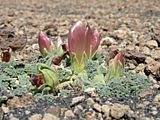UV-B stress
Among the traditional beliefs about alpine plant stress, the one that UV-radiation is destructive ranks very high, although there is no evidence in support of this. The epidermis of alpine plants contains UV-absorbing substances, in part the same that are used in suntan cream (e.g. flavonoids). Also chloroplasts are packed with protective pigments (e.g. carotenes). A comparison of the actual UV-B exposure of the leaf interior between arctic lowland, temperate and tropical mountains revealed no difference, although the surface exposure differs dramatically.
To test the influence of UV-B radiation on all sorts of alpine plant characteristics, alpine plants have been experimentally exposed to natural and artificially reduced UV-B in situ, and no differences have been found (experiments with UV-transmissive and absorptive glass, Robberecht et al. 1980). These experiments have also proven that the stunted growth, small size and colourful flowers have nothing to do with the higher intensity of UV-B radiation in the Alpine.
In all cases, the key driver for whole plant stature and leaf size (beyond its genetic determination) was the overall light intensity and not the UV compound. In line with this, UV hardening (acclimation) is induced by high light intensity, irrespective of the UV content.
However, experiments with several years of enhanced UV radiation (as may result from a continued depletion of the ozone layer) in the arctic have revealed small changes in plant performance in some species, but not in all.
In summary, both, total and UV-B radiation, do not exert significant (destructive) stress in species which are acclimated and adapted to the alpine environment.


